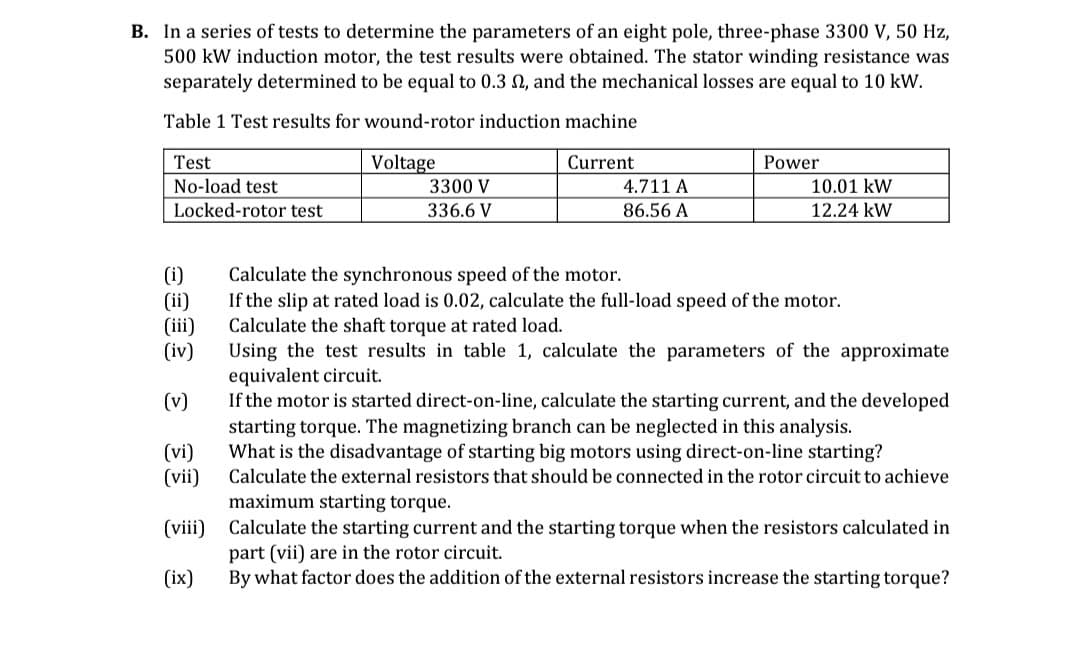B. In a series of tests to determine the parameters of an eight pole, three-phase 3300 V, 50 500 kW induction motor, the test results were obtained. The stator winding resistance w separately determined to be equal to 0.3 02, and the mechanical losses are equal to 10 kW. Table 1 Test results for wound-rotor induction machine Test Voltage Current Power No-load test 3300 V 4.711 A 10.01 kW Locked-rotor test 336.6 V 86.56 A 12.24 kW (i) Calculate the synchronous speed of the motor. (ii) If the slip at rated load is 0.02, calculate the full-load speed of the motor.
B. In a series of tests to determine the parameters of an eight pole, three-phase 3300 V, 50 500 kW induction motor, the test results were obtained. The stator winding resistance w separately determined to be equal to 0.3 02, and the mechanical losses are equal to 10 kW. Table 1 Test results for wound-rotor induction machine Test Voltage Current Power No-load test 3300 V 4.711 A 10.01 kW Locked-rotor test 336.6 V 86.56 A 12.24 kW (i) Calculate the synchronous speed of the motor. (ii) If the slip at rated load is 0.02, calculate the full-load speed of the motor.
Introductory Circuit Analysis (13th Edition)
13th Edition
ISBN:9780133923605
Author:Robert L. Boylestad
Publisher:Robert L. Boylestad
Chapter1: Introduction
Section: Chapter Questions
Problem 1P: Visit your local library (at school or home) and describe the extent to which it provides literature...
Related questions
Question
V, Vii, Viii...
With explanation

Transcribed Image Text:B. In a series of tests to determine the parameters of an eight pole, three-phase 3300 V, 50 Hz,
500 kW induction motor, the test results were obtained. The stator winding resistance was
separately determined to be equal to 0.3 02, and the mechanical losses are equal to 10 kW.
Table 1 Test results for wound-rotor induction machine
Test
Voltage
Current
Power
No-load test
3300 V
4.711 A
10.01 kW
Locked-rotor test
336.6 V
86.56 A
12.24 kW
(i)
Calculate the synchronous speed of the motor.
(ii)
If the slip at rated load is 0.02, calculate the full-load speed of the motor.
Calculate the shaft torque at rated load.
(iii)
(iv)
Using the test results in table 1, calculate the parameters of the approximate
equivalent circuit.
(v)
If the motor is started direct-on-line, calculate the starting current, and the developed
starting torque. The magnetizing branch can be neglected in this analysis.
(vi)
(vii)
What is the disadvantage of starting big motors using direct-on-line starting?
Calculate the external resistors that should be connected in the rotor circuit to achieve
maximum starting torque.
(viii)
Calculate the starting current and the starting torque when the resistors calculated in
part (vii) are in the rotor circuit.
(ix)
By what factor does the addition of the external resistors increase the starting torque?
Expert Solution
This question has been solved!
Explore an expertly crafted, step-by-step solution for a thorough understanding of key concepts.
Step by step
Solved in 5 steps

Knowledge Booster
Learn more about
Need a deep-dive on the concept behind this application? Look no further. Learn more about this topic, electrical-engineering and related others by exploring similar questions and additional content below.Recommended textbooks for you

Introductory Circuit Analysis (13th Edition)
Electrical Engineering
ISBN:
9780133923605
Author:
Robert L. Boylestad
Publisher:
PEARSON

Delmar's Standard Textbook Of Electricity
Electrical Engineering
ISBN:
9781337900348
Author:
Stephen L. Herman
Publisher:
Cengage Learning

Programmable Logic Controllers
Electrical Engineering
ISBN:
9780073373843
Author:
Frank D. Petruzella
Publisher:
McGraw-Hill Education

Introductory Circuit Analysis (13th Edition)
Electrical Engineering
ISBN:
9780133923605
Author:
Robert L. Boylestad
Publisher:
PEARSON

Delmar's Standard Textbook Of Electricity
Electrical Engineering
ISBN:
9781337900348
Author:
Stephen L. Herman
Publisher:
Cengage Learning

Programmable Logic Controllers
Electrical Engineering
ISBN:
9780073373843
Author:
Frank D. Petruzella
Publisher:
McGraw-Hill Education

Fundamentals of Electric Circuits
Electrical Engineering
ISBN:
9780078028229
Author:
Charles K Alexander, Matthew Sadiku
Publisher:
McGraw-Hill Education

Electric Circuits. (11th Edition)
Electrical Engineering
ISBN:
9780134746968
Author:
James W. Nilsson, Susan Riedel
Publisher:
PEARSON

Engineering Electromagnetics
Electrical Engineering
ISBN:
9780078028151
Author:
Hayt, William H. (william Hart), Jr, BUCK, John A.
Publisher:
Mcgraw-hill Education,